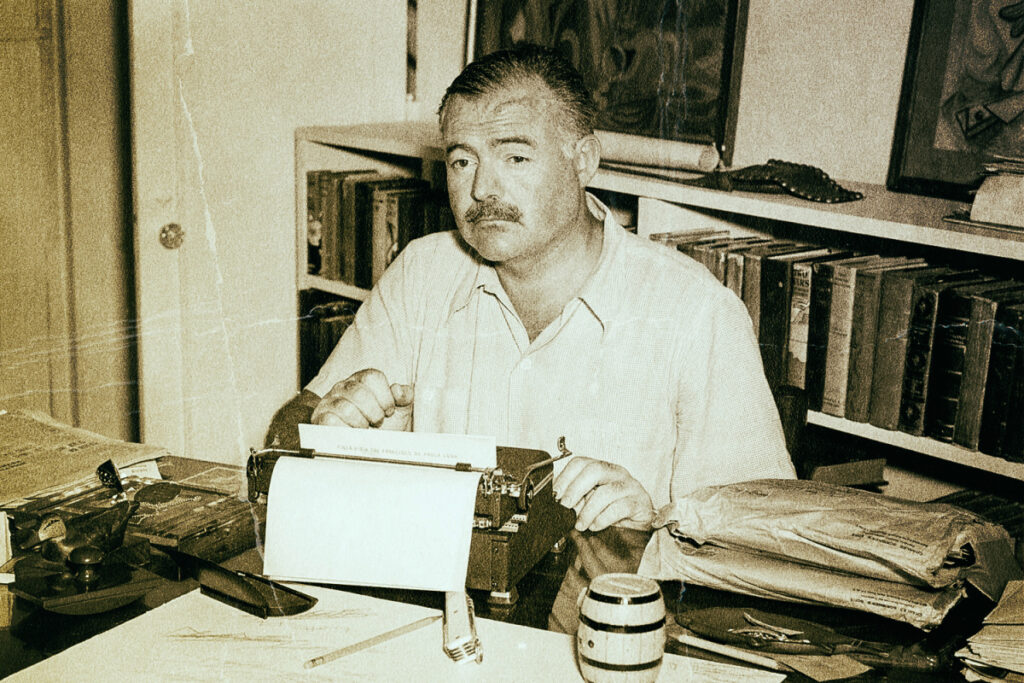Ernest Hemingway inspired many Latin American writers. Perhaps in none did he leave a stronger impression than in Gabriel García Márquez. Márquez was walking in Paris in the spring of 1957 when he saw, on the opposite side, the unmistakable figure of Hemingway. In one of his articles, Gabriel García Márquez recounts this moment,
“I recognized him immediately, as he passed with his wife Mary Welsh on the Boulevard St. Michel in Paris one rainy spring day in 1957. He walked on the other side of the street toward the Luxembourg Gardens, wearing a worn pair of cowboy pants, a plaid shirt and a ballplayer’s cap. The only thing that didn’t look as if it belonged to him was a pair of metal-rimmed glasses, tiny and round, which gave him a premature grandfatherly air. For a fraction of a second, as always seemed to be the case, I found myself divided between my two competing roles. I didn’t know whether to ask him for an interview or cross the avenue to express my unqualified admiration for him. But with either proposition, I faced the same great inconvenience. I spoke the same rudimentary English I speak to this day, and I wasn’t very sure about his bullfighter’s Spanish. And so, I didn’t do either of the things that could have spoiled that moment, but instead cupped both hands over my mouth and, like Tarzan in the jungle, yelled from one sidewalk to the other: ‘Maeeestro!’ Ernest Hemingway understood that there could be no other master amid the multitude of students, and he turned, raised his hand and shouted to me in Castilian in a very childish voice, ‘Adiooós, amigo!’ It was the only time I saw him”. García Márquez thus expressed his appreciation for one of the two authors who most influenced his work (the other was William Faulkner).
Hemingway in Cuba
Cuba, where he lived for several years, had a big influence on Hemingway’s life. His first trip to the island was in April of 1934, together with his second wife, Pauline Pfeiffer. However, it was his third wife, Martha Gellhorn, who chose their home in Finca Vigía, located on the small hill of San Francisco de Paula, a few kilometers away from Havana.
In addition to Finca Vigía, Hemingway’s preferred places in Cuba were the room in the Hotel Ambos Mundos, where he sometimes secluded himself to write, his frequently visited bar Floridita and the restaurant Bodeguita del Medio. The latter was a favorite as well of Errol Flynn, Gabriela Mistral, Salvador Allende, Gabriel García Márquez, Pablo Neruda, and many other well-known personalities. The daiquiri “Papa Hemingway” that he invented is still a specialty at the Floridita: two lines of rum, a hit of lemon and two servings of crushed ice, leaving the glass frost-lined.
In Cuba, Hemingway wrote Across the River and Into the Trees, A Moveable Feast, Gulf Islands and Cuba’s iconic novel The Old Man and the Sea. In this last work, Hemingway said he found the literary tone he had sought all his life. That book won him the Pulitzer Prize in 1952 and catapulted him to the Nobel Prize in October 1954. In the words of the Nobel Prize committee, he received it for his “mastery of the art of storytelling, which was recently demonstrated in The Old Man and the Sea, and the influence it has exerted on contemporary style,” which consisted of simple sentences and simple syntax, almost telegraphic in its expression. “This is one prize that belongs to Cuba, because my work was conceived and created in Cuba,” he said.
Hemingway called his style the “iceberg theory” where the facts float on water and the support structure and symbolism operate out of sight. Many critics tried to find a hidden symbolism in The Old Man and the Sea. However, as Hemingway wrote in a letter, “There isn’t any symbolism. The sea is the sea. The old man is an old man. The boy is a boy and the fish is a fish. The sharks are all sharks, no better and no worse. All the symbolism that people say is shit.”
Hemingway’s last years
In his last years Hemingway was besieged by alcoholism and disease. It is possible that like his father, who killed himself, he suffered from hereditary haemochromatosis. In this disease, there is an excessive accumulation of iron in the body tissues that culminates in physical and mental deterioration. Both his sister Ursula and his brother Leicester also committed suicide. Because of his deep depression, he was treated with electroconvulsive therapy (ECT) in the psychiatric section of St. Mary’s Hospital in Rochester, Minn. eleven times in 1960.
During a flight to the Mayo Clinic, he tried to jump from the plane, and during a technical stop in Casper, Wyo. for repairs, he tried to walk into the moving propeller. After he was released from the clinic, he twice attempted suicide with a gun kept in the vestibule rack in his house. When his friend, A.E. Hotchner, asked him why he wanted to kill himself, Hemingway answered, “What do you think happens to a man going on 62 when he realizes that he can never write the books and stories he promised himself? Or do any of the other things he promised himself in the good days?”
In an interview with George Plimpton for The Paris Review, Hemingway said, “Once writing has become the main vice and the greatest pleasure, only death can end it”. Maybe those were his thoughts when following what appeared to be a tragic family tradition, he ended his life in Ketchum, Idaho, with his favorite shotgun, one somber dawn of July 2, 1961.
(Dr. Cesar Chelala is a co-winner of the 1979 Overseas Press Club of America award for the article “Missing or Disappeared in Argentina: The Desperate Search for Thousands of Abducted Victims.” Courtesy: CounterPunch.)




